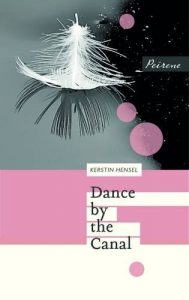Published by Peirene Press 18 September 2017
128pp, paperback, £12.00
Reviewed by Alison Burns
Early in this short, sharp novella set in East Germany, the narrator describes her privileged, protected, pressurized childhood, when there was ‘goose liver pate on the table and Mozart on the record player’. In the garden of her parents’ villa, she played unsteady solo hopscotch until she ‘fell by the wayside’.
The wider sense of falling by the wayside lies at the heart of her story.
Lessing Prize winner Kerstin Hensel’s book, first published in 1994 (the year in which it is set), introduces us to a homeless young woman, Gabriela, who sleeps under a canal bridge. Gabriela eats, washes and gets clothes at a shelter. She scavenges mainly for things to write on – anything from abandoned food-wrappers to packing paper. In her story, she is proud and defiant, distinguishing herself from most other down-and-outs because: ‘They don’t know how to tell their story. They’ve just fallen. Right to the bottom.’ However, throughout the narrative – which moves from the present to the past and back again – she refers to her dread of awakening: ‘Anything but that, anything but the fear of seeing myself.’ So she has fallen, all right, if not to the bottom.
When the story of Gabriela’s childhood opens, her father is a respected vascular surgeon. At school, she is deemed to be from the intelligentsia and thus, according to one of the teachers, ‘a bourgeois relic’. Her mainly working-class schoolfellows laugh at her, until she joins forces with dirty Katke, who is up for truanting by the canal and fooling around generally. It is as well that Gabriela has a friend and some escape from home, for hers is not a happy one. There is a brief period, after her father’s promotion to Senior Medical Officer, when the house is full of distinguished doctors, writers and artists; but her father is a drunk, hooked on prestige, and he loses his position. Her mother eventually takes an amusing young actor for her lover, and gets a divorce.
Gabriela moves with her father into a small flat and everything goes downhill from there, for both of them. She fails at school, is miserable at home, takes refuge in reading and then is sent to an industrial plant as an apprentice mechanical engineer (secondary and tertiary education being reserved for the workers). He eventually leaves home, too.
By the time we first meet Gabriela, her world has shrunk to the canal, the park, the homeless shelter, the seasons and the bar. This young woman, who was assaulted by her piano teacher at the age of five, is raped in that park and gets no sympathy from the police; but still she fights back. When, even at the shelter, she notices ‘a pitying shake of the head’, her response is: ‘But I know who I am.’ What we don’t know yet is that she ran away from the industrial plant and, for punishment, was signed up as an informer: another role that she managed to evade.
Here, in Leibnitz, in 1994, under her canal bridge, she has made a life for herself, if only to be left in peace for long enough to record it. Her ‘salvation’, if that is what it is, comes from two unlikely directions, which I won’t spoil for the reader.
This is another extraordinarily powerful tale from the Peirene fountain: a somewhat uncomfortable read, but full of food for thought. Die Zeit acclaimed this work, with reason, as ‘thirty years of East German history narrated with laconic irony’.

